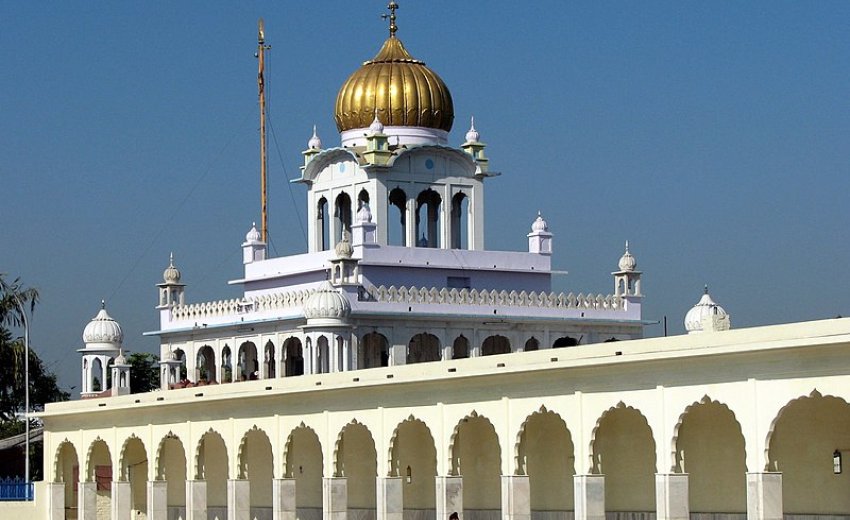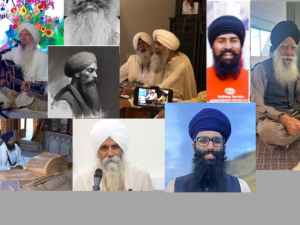Guru Gobind Singh Sahib in order to overcome the mental slavery of the people of Hindustan, not only fought courageous struggles but also a new chapter of the concept of eternal necessity was added to history. The determination, self-belief, courage and spirit of sacrifice of Guru Gobind Singh Sahib laid the footsteps of fearless fighting in the struggle of life for all times. Guru Sahib initiated such a soul into the dead nation by performing sacrifices, deeds and gifts at his young age, which was a wonderful charisma in the history of the world. On the dates of 5th and 6th December 1704. Anandpur Sahib had been besieged by Mughals, Pahari Rangers and Gujars for eight months. The situation in Anandpur Sahib had become very serious and a painful situation. All means of getting rations of water inside the fort had been stopped by the enemy forces. There were about 460 Singhs, Singhanis and innocent children inside the fort. The Singhs were keeping their Siddak strong even by living on the leaves of the trees. The Parsadi elephant received as a gift from Tripura Raja had also died of starvation. The Singhs could no longer tolerate hunger. Singh wanted to leave the Anandpur fort. After considering, the decision to bid farewell to Anandpur Sahib was announced.
On the one hand, the encirclement of the enemy forces, the scattered and terrible roads, the torrential rains, forests , the dark black night and the mighty Sarsa River and on the other hand, the determination, self-belief, iron-will and sacrifice of the Kalgiwale, the hopes turned upside down . About 460 Singhs, Mata Gujri ji, Chaar Sahibzades, Bibi Bhikhan and Subhikhi were included in this caravan . This entire caravan continued to walk silently till Kiratpur Sahib. Passing the turn from Kiratpur to Bilaspur and going towards Sarsa river, the one hilly saw this caravan and informed the troops. The Singhs were informed that the mountain troops were coming near the village of Jhakkhian. On receiving this news, Guru Sahib gave strict instructions to the Warrior Singhs to take a special position. Bhai Uday Singh ordered 50 Singhs to march towards Shahi Tibbi. Bhai Jeevan Singh (Jaita) was instructed to set up a frontline of 100 Singhs on the banks of Sarsa river. The third batch of one hundred (100) Singhs under the command of Bhai Bachitar Singh to stop Nawab Sirhind's army coming to Chamkaur . Guru Sahib instructed Bhai Uday Singh to inform Sahibzada Ajit Singh and Bhai Budha Singh that they should cross Sarsa river and reach Bhai Nihang Khan's fort in Kotla village. During this time, Mata Gujri ji and younger sons of Dashmesh Pita , his two servants Bhai Sunna Singh and Bibi Subhikhi crossed the Sarsa river and went to Chamkaur. Gangu Brahmin (cook) took Mata Gujri ji and two younger Sahibzades to his village Saheri (Kheri). A handful of Singhs fought bravely in 'Chamkaur Di Garhi' in which 37 Singhs along with two Vade Sahibzades were martyred. Guru Sahib and Panj Singh remained in the fort till night time (December 7, 1705). At night, the five Singhs performed Gurmata, which Guru Sahib had to gladly accept. On the night of 7 December 1705, Guru Sahib and three Singhs, came out of the fort. Only two Singhs, Bhai Sant Singh Bageshri and Bhai Sangat Singh Arora, remained in the Garhi, in which Bhai Sangat Singh Arora was dressed by Guru Sahib in his kalgi, clothes etc,and on December 8 enemy forces attacked Garhi and the two Singhs achieved martyrdom while fighting with the forces.
SAHIBZADA AJIT SINGH JI :
Sahibzade Ajit Singh( 1687- 1705) born in the house of Guru Gobind Singh and Mata Sunder Kaur at Paonta Sahib. Sahibzada Ajit Singh and Sahibzada Jujhar Singh are remembered as 'Vade Sahibzade' in Sikh history. Sahibzade Ajit Singh was very intelligent, gifted with Gurbani and agile from his childhood. At an early age, he mastered horse riding and gun shooting. On 23 May 1699, while commanding a group of one hundred Singhs, he successfully raided the nearby village of Ranghars, who had once plundered the company of Pothohar Sikhs coming towards Anandpur Sahib. On 15 March 1700, he attacked the Gujars of Bajrur village, who Once robbed the caravan of Singhs. On August 29, 1700, when the hill kings attacked the Taragarh fort, Sahibzada Ajit Singh bravely defeated the attack along with the Singhs. Similarly, in October 1700 again the mountain forces attacked Nirmohgarh, Sahibzada took the lead and fought vigorously and killed many hilly soldiers. Once the Dwarka Das Brahmin's wife was taken away by the ruler of Bassi Kalan . On March 7, 1703, along with Bhai Uday Singh, Sahibzada with a group of one hundred (100) Singhs rescued the wife of a Brahmin from Basi Kalan and handed her over to the Brahmin. Sahibzada Ajit Singh spent most of his life on the land of Anandpur Sahib. In May 1705, when Anandpur Sahib was besieged by Hilly and Mughal forces, he was also there. Both the elder Sahibzadas were with their father while leaving Anandpur Sahib. When forty Singhs fought a fierce battle in the fort of Chamkaur, Sahibzada Ajit Singh went to the battlefield with Singh spirit and showed his bravery and killed many enemies. "Gur Sobha" testifies this. Sahibzada Ajit Singh's total age at the time of martyrdom was 18 years 11 Months and 19 days.
SAHIBZADA JUJHAR SINGH JI :
Sahibzada Jujhar Singh ( 1691-1705) was born in the house of Guru Gobind Singh and Mata Jit Kaur at Anandpur Sahib. Since his childhood, he was very intelligent, Gurbani oriented , skilled in horse riding and archery. When Guru Sahib left Anandpur Sahib, he was also a companion. During the war of Chamkaur, he left the fort and fought face-to-face, killed many enemy soldiers and achieved martyrdom. Before the start of this war, Guru Sahib introduced both the Sahibzadas to the tradition of martyrdom. The battle started at noon and continued until sunset. Guru Sahib has also mentioned this war in 'Zafarnama'.The details of this battle are also found in 'Bhatvahi Multani Sindhi”. By evening only five Singhs were left in this battle. At night, Guru Sahib went out of the fort with three Singhs. Two Singhs were martyred while fighting on the morning of December 8, 1705.
SAHIBZADA ZORAWAR SINGH JI :
Sahibzada Zorawar Singh ( 1696- 1705 ) was born at Anandpur Sahib to Mata Jit Kaur in the house of Guru Gobind Singh . From an early age, his heart was burning with the learned spirit. When Guru Sahib decided to leave Anandpur Sahib, he was also with him. Both the younger Sahibzadas had traveled with Mata Gujri ji.
Mata Gujri and the younger Sahibzades were taken by the cook Gangu Brahmin to the village Saheri(Kheri) near Morinda. He sheltered them in his house. In the morning, Gangu arrested Mata Gujri and the younger Sahibzadas and handed them over to Subedar Wazir Khan of Sirhind and all the royal prisoners were imprisoned in the cold tower. On the second day, the Subedar's soldiers took the Sahibzadas to present them in the court. When Sahibzadas appeared in the court, they chanted
Waheguru Ji Ka Khalsa
Wahe Guru ji ke Fateh.
First, these two innocent children were offered to convert to Islam with promises. When they flatly refused, tactics of torture and threats were used. Nawab Sher Muhammad Khan of Malerkotle forbade Subedar Wazir Khan from killing innocent children. Subedar's Diwan Sucha Nand, who was present in the court, incited Wazir Khan to kill them. Subedar Wazir Khan ordered the innocent children to be bricked alive in the walls. This incident is of December 12, 1705. After a few hours, when the walls came up on the shoulders, both the Sahibzadas were killed. Sahibzada Zorawar Singh's total age at the time of martyrdom was 9 years, one month and five days.
SAHIBZADA FATEH SINGH JI :
Sahibzada Fateh Singh ( 1699-1705) was born in the house of Guru Gobind Singh and Mata Jit Kaur at Anandpur Sahib. Fateh Singh was one year and ten months old at that time of the demise of his mother . So the upbringing of these two young heroes was approved under the care of grandmother Mata Gujri ji. Mata Gujri ji and elder brother Zorawar Singh also came out of the fort together. Later by crossing the Sarsa river , Gangu Brahmin took them to his village Kheri. Innocent children were given a lot of greed , but after suffering all kinds of torture, they achieved martyrdom, which is unique and unparalleled in the history of the world. They stood still and shattered the plans of the tyrants. For the first time in the history of the world, innocent children could not be persuaded by future happiness,threats of torture and fear of death to abandon their glorious religion. In this way innocent children set an example of sacrifice for their religion and freedom. Both of these Sahibzadas were tortured by cutting their heads . Guru Gobind Singh Sahib wrote in Zafarnama to Aurangzeb that what happened, you have killed my four children but the Khalsa is still alive. After the martyrdom of the younger Sahibzades, Mata Gujri ji was also tortured and killed in the cold tower by the subedar's soldiers. A merchant Diwan Todar Mall purchased the land by placing gold coins cremated Mata Gujri ji and the younger Sahibzades. Gurdwara Fatehgarh Sahib is here now. It is considered to be the most valuable land in the history of the world.






